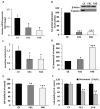Altered Secretome and ROS Production in Olfactory Mucosa Stem Cells Derived from Friedreich's Ataxia Patients
- PMID: 32933002
- PMCID: PMC7555998
- DOI: 10.3390/ijms21186662
Altered Secretome and ROS Production in Olfactory Mucosa Stem Cells Derived from Friedreich's Ataxia Patients
Abstract
Friedreich's ataxia is the most common hereditary ataxia for which there is no cure or approved treatment at present. However, therapeutic developments based on the understanding of pathological mechanisms underlying the disease have advanced considerably, with the implementation of cellular models that mimic the disease playing a crucial role. Human olfactory ecto-mesenchymal stem cells represent a novel model that could prove useful due to their accessibility and neurogenic capacity. Here, we isolated and cultured these stem cells from Friedreich´s ataxia patients and healthy donors, characterizing their phenotype and describing disease-specific features such as reduced cell viability, impaired aconitase activity, increased ROS production and the release of cytokines involved in neuroinflammation. Importantly, we observed a positive effect on patient-derived cells, when frataxin levels were restored, confirming the utility of this in vitro model to study the disease. This model will improve our understanding of Friedreich´s ataxia pathogenesis and will help in developing rationally designed therapeutic strategies.
Keywords: Frataxin; Friedreich´s ataxia; gene therapy; stem cells human olfactory mucosa.
Conflict of interest statement
The authors declare no conflict of interest.
Figures






Similar articles
-
Adding a temporal dimension to the study of Friedreich's ataxia: the effect of frataxin overexpression in a human cell model.Dis Model Mech. 2018 Jun 25;11(6):dmm032706. doi: 10.1242/dmm.032706. Dis Model Mech. 2018. PMID: 29794127 Free PMC article.
-
Drug repositioning screening identifies etravirine as a potential therapeutic for friedreich's ataxia.Mov Disord. 2019 Mar;34(3):323-334. doi: 10.1002/mds.27604. Epub 2019 Jan 9. Mov Disord. 2019. PMID: 30624801
-
Lipophilic methylene blue analogues enhance mitochondrial function and increase frataxin levels in a cellular model of Friedreich's ataxia.Bioorg Med Chem. 2018 Jul 23;26(12):3359-3369. doi: 10.1016/j.bmc.2018.05.005. Epub 2018 May 4. Bioorg Med Chem. 2018. PMID: 29773347
-
Friedreich's ataxia.Pediatr Neurol. 2003 May;28(5):335-41. doi: 10.1016/s0887-8994(03)00004-3. Pediatr Neurol. 2003. PMID: 12878293 Review.
-
Oxidative stress, mitochondrial dysfunction and cellular stress response in Friedreich's ataxia.J Neurol Sci. 2005 Jun 15;233(1-2):145-62. doi: 10.1016/j.jns.2005.03.012. J Neurol Sci. 2005. PMID: 15896810 Review.
Cited by
-
Olfactory Ecto-Mesenchymal Stem Cells in Modeling and Treating Alzheimer's Disease.Int J Mol Sci. 2024 Aug 3;25(15):8492. doi: 10.3390/ijms25158492. Int J Mol Sci. 2024. PMID: 39126059 Free PMC article. Review.
-
The smoothened agonist SAG reduces mitochondrial dysfunction and neurotoxicity of frataxin-deficient astrocytes.J Neuroinflammation. 2022 Apr 12;19(1):93. doi: 10.1186/s12974-022-02442-w. J Neuroinflammation. 2022. PMID: 35413853 Free PMC article.
-
Effect of Mitochondrial and Cytosolic FXN Isoform Expression on Mitochondrial Dynamics and Metabolism.Int J Mol Sci. 2020 Nov 4;21(21):8251. doi: 10.3390/ijms21218251. Int J Mol Sci. 2020. PMID: 33158039 Free PMC article.
-
Loss of filamentous actin, tight junction protein expression, and paracellular barrier integrity in frataxin-deficient human brain microvascular endothelial cells-implications for blood-brain barrier physiology in Friedreich's ataxia.Front Mol Biosci. 2024 Jan 11;10:1299201. doi: 10.3389/fmolb.2023.1299201. eCollection 2023. Front Mol Biosci. 2024. PMID: 38274097 Free PMC article.
References
-
- Evans-Galea M.V., Lockhart P.J., Galea C.A., Hannan A.J., Delatycki M.B. Beyond loss of frataxin: The complex molecular pathology of Friedreich ataxia. Discov. Med. 2014;17:25–35. - PubMed
-
- Campuzano V., Montermini L., Moltò M.D., Pianese L., Cossée M., Cavalcanti F., Monros E., Rodius F., Duclos F., Monticelli A., et al. Friedreich’s ataxia: Autosomal recessive disease caused by an intronic GAA triplet repeat expansion. Science. 1996;271:1423–1427. doi: 10.1126/science.271.5254.1423. - DOI - PubMed
MeSH terms
Substances
Grants and funding
LinkOut - more resources
Full Text Sources
Medical
Research Materials

